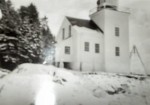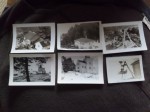Life on Pine Island c. 1950s
Here is another story from Ms. Juanita (Swanson) DuLong. She was a young girl on most of these stations, but living there, and hearing stories from her parents, she has created lighthouse memories from the 1950s time. Her older stories are found here and here.
Her husband Roy scanned some nice photos of Pine Island station, but unfortunately they are way too small to show here. When he has time to make larger ones, I will add them.
Roy sent some more scans, but they are limited, but I have posted them because they show details not available before – e.g. the A-frame highline setup.
*************************

There may be somewhere in the world a place foggier than Pine Island lighthouse, but it’s hard to believe. The horn was often on for days on end, and became only another background noise. A lighthouse tender could arrive in clear weather, and radio that Pine was under a doughnut of fog.

The Estevan’s captain Ormiston’s gravelly voice always radioed the same way. “Hello Pine Island. Hi Art, how’s the old woman!?” Dad and he would chat, discuss ETA, then we prepared for their arrival.
Station supplies varied through the four yearly Tender visits. Along with our groceries and mail, there could be oil barrels, engine parts, correspondence school lessons, (I began grade one here) boxed rags for the engine room, library books and sometimes, the Superintendant of Lights

on an inspection tour.
My folks ran a ship-shape station and its a good thing! Colonel Dixon could be a bit of a stickler.
The captain and crew often brought us treats. Maybe a crew member’s discarded paper-back books, fresh fruit, a chocolate bar for me, or dog treats for our spaniel Sandy. For her whole life Sandy loved a man in uniform!

Landing visitors and supplies at Pine had to be done just so. The gully was treacherous. It was said to have claimed the life of a small girl in the past. The Tender lay offshore as the landing boat maneuvered underneath the hook. Our own station-boat was also brought up this way. Supplies went up and over on the cable. People landed below at a set of stairs. This also was a challenge. Any business in the gully had to have the tide just right.
 The main house had pretty basic plumbing, the cottage had a more modern system, complete with a bathtub. The stove must been wood and coal, as we discovered the tub piled high with coal! The bathroom was laid out the same as Sisters Island lighthouse, where weights for the light mechanism ran behind one wall. Mom norrowly escaped at Sisters when the weights let go, smashing through the wall, and the toilet. Quite a newspaper headline, that would have made…..!
The main house had pretty basic plumbing, the cottage had a more modern system, complete with a bathtub. The stove must been wood and coal, as we discovered the tub piled high with coal! The bathroom was laid out the same as Sisters Island lighthouse, where weights for the light mechanism ran behind one wall. Mom norrowly escaped at Sisters when the weights let go, smashing through the wall, and the toilet. Quite a newspaper headline, that would have made…..!
I can remember three assistants over our four or five years at Pine. One was Cliff, an elderly gentlemen. He played violin and thought passing whales were sea monsters.Another was a young guy in his late teens, for a summer only. Dad spooked him with his stories of drowned littles girl’s ghost. Walter Ganilka was with us the longest, and made the transfer to Nootka when we moved.
Mom could stop the engine. the huge, bulky wheels were too heavy for her to start. I remember the engine room and all equipment as spotless and tidy. Dad was very particular in his work, absent-minded in the house.
Besides the dog, who arrived as a gift (in my brother Tom’s pocket!) we soon acquired a cat, D.B. and a rabbit Benny. All were characters and got along well. Benny even struck up a friendship with one of the islands tame deer. There were moments that looked like a scene out of Bambi.

Rhinoseros Auklets nested in burrows. Night birds mostly, we rarely saw them. Puffins were a common sight. Pine Island must have been on a migratory bird route as we often saw non-resident birds. Mom identified an Evening Grosbeak and a Scarlet Tanager, among others.
